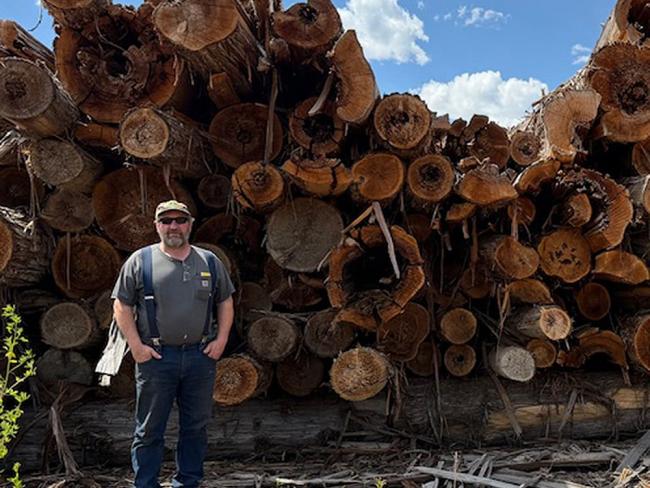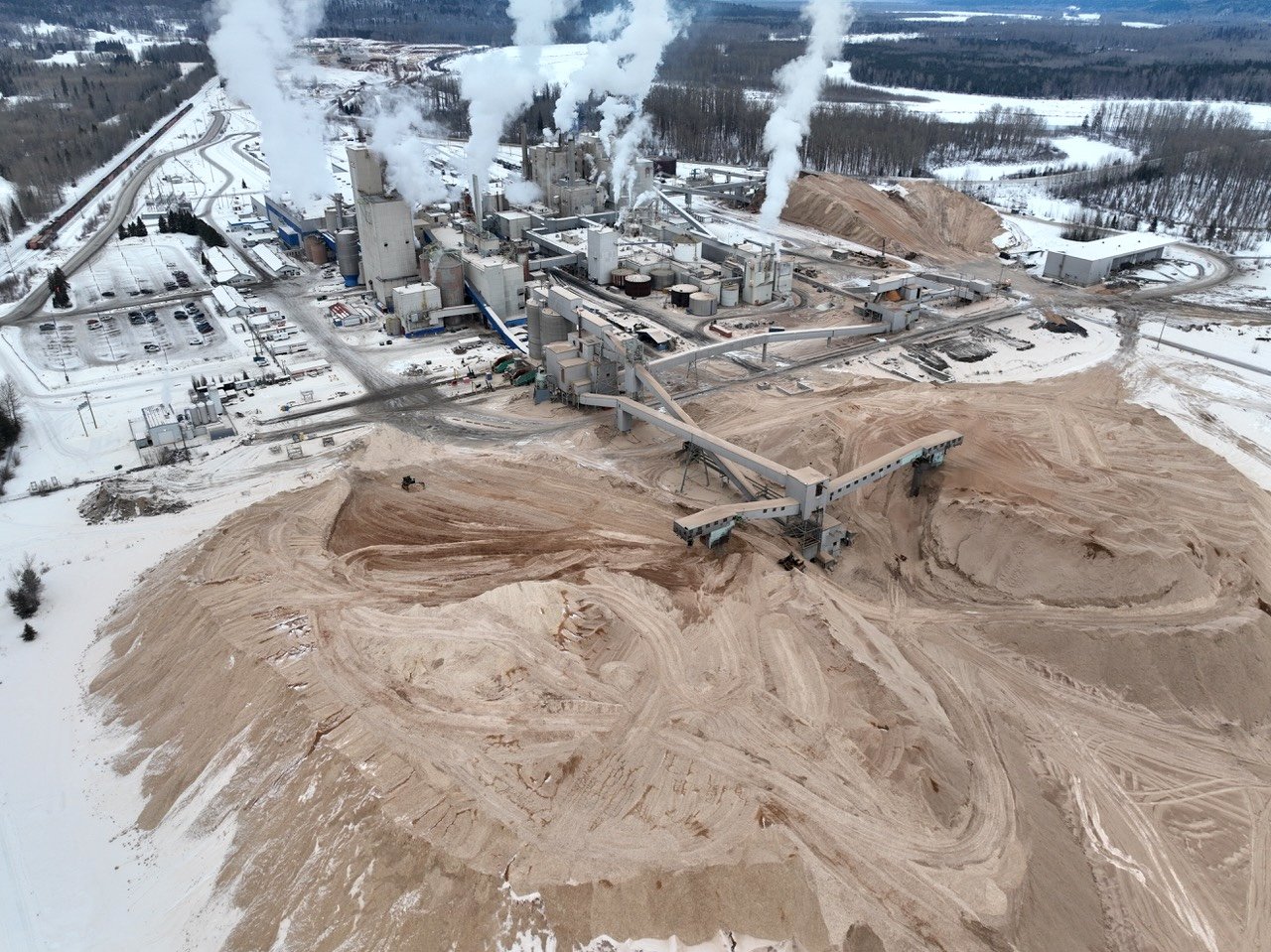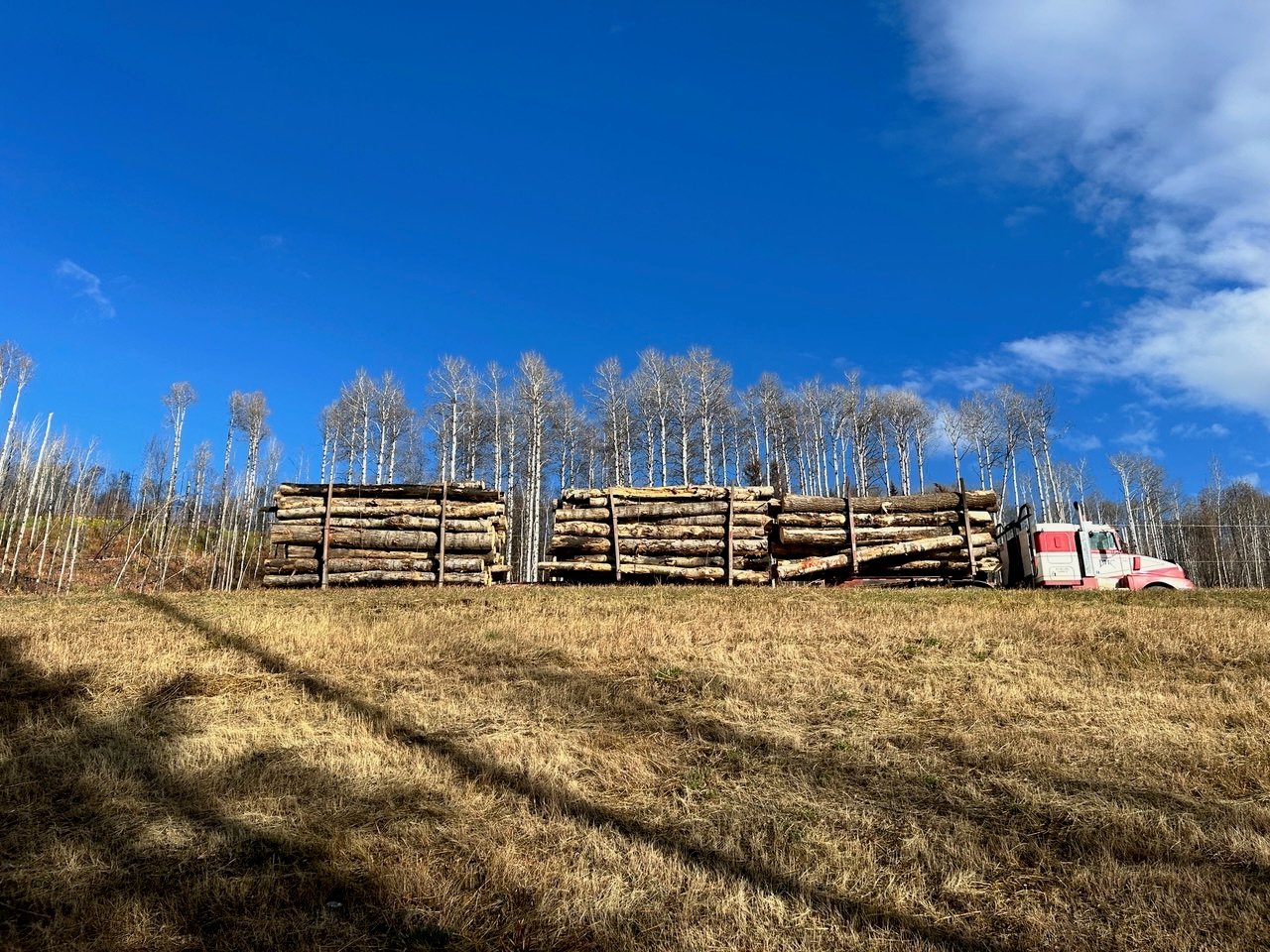Articles Menu

July 25, 2025
In an industry dominated by high-tech sawmills that churn out tens of millions of two-by-fours and two-by-sixes a year, a small mill in the village of Valemount is both the exception to the rule and a symbol of what might be.
The 14 workers at the Cedar Valley Holdings mill work as a team, calling the shots on each and every log entering the facility.
Nothing goes to waste. Virtually every unit of wood in every cedar log entering the mill, including their frequently rotted cores, gets turned into one product or another — from cedar shakes and shingles, to stakes, to fencing products and mulch.
It’s precisely the sort of value-added operation that Premier David Eby told Forests Minister Ravi Parmar in his mandate letter should be the goal in British Columbia’s forest industry.
Yet the mill that epitomizes getting the most out of each log processed is in trouble.
Many logs that the mill could use are instead being trucked to Prince George, a three-hour drive to the northwest, where they are thrown into a giant chipper to make wood pulp.
Rubbing salt in the wound, the logs being chipped for pulp come from big, old cedar trees and originate in forests licensed to the Valemount Community Forest, whose mandate, in part, is to “promote small and value-added manufacturing” and “industrial diversity.”
Valemount Mayor Owen Torgerson says both those objectives fit Cedar Valley’s operations to a tee.
“There’s no automation at Cedar Valley. Everything is hands on. That same piece of cedar that comes into the mill is looked at by 14 people,” Torgerson told The Tyee. “And we’re sending potential value-added wood that could be manufactured locally to a pulp mill, which is potentially the lowest value? Why?”
It’s a question with relevance to rural communities across B.C. as economically viable timber supplies dwindle due to decades of logging at rates the B.C. government and the industry it regulates knew could not be sustained.
An investigation by The Tyee shows that some of the biggest forest companies in the province are turning to community forests to make up the shortfall, placing smaller rural communities and local mills in jeopardy.
Left unaddressed, community forests will morph into corporate forests, and their communities, like Valemount, will become nothing more than log suppliers to companies headquartered far away.
“Other options need to be put on the table,” Torgerson said.
Community forests, corporate control
As evidence began to surface last fall that cedar logs were leaving Valemount’s forests to be processed nearly 300 kilometres away in Prince George’s pulp mills, Cedar Valley’s owner and manager, Jason Alexander, informed his employees that unless things changed and the community forest’s board and managers found a way to provide his mill a reliable number of logs, he would be forced to end operations by the end of June.
That deadline has been pushed back as he and the board’s managers try to find a way to renew the latter half of a 20-year log supply agreement that is at its midpoint and up for review and renewal. Alexander now says he’s “cautiously optimistic” a solution will be found.
In comments to the local newspaper the Rocky Mountain Goat in May, Alexander said: “I cannot express... how foolish it is for the Valemount Community Forest to be shipping logs that we need to the pulp mill in Prince George. It’s irresponsible.”
On the heel of that article and others, The Tyee investigated where logs from Valemount’s community forest are going. It also looked more broadly at where logs from community forests across the province go.
Using a searchable database maintained by B.C.’s Ministry of Forests, The Tyee analyzed all logging activities in 2024 in forests where communities hold exclusive, provincially approved logging licences. The list includes both Indigenous and non-Indigenous communities.
The data shows that in total more than 2.74 million cubic metres of logs came from community forests and First Nations’ woodlands last year and that 47 per cent of those logs went to just five companies, with the top company, Canadian Forest Products, or Canfor, commanding 14 per cent of all the logs coming out of community forests and First Nations’ woodlands last year.

When the list is expanded to include the top 10 purchasers of community forest logs, those companies control a formidable 70 per cent — more than two out of every three trees coming out of community forests. The expanded list includes West Fraser, a company that, like Canfor, is also a major lumber and wood pulp producer, and Kruger Kamloops Pulp LP, a pulp company in the southern Interior of the province.
Also in the top 10 are Western Forest Products, the largest forest company on B.C.’s coast, and A&A Trading Ltd., a log brokerage that markets raw, unprocessed logs to out-of-country buyers who often pay premium prices, leaving domestic mills in B.C. to do without.
Not enough wood to go around
The high concentration of community forest logs in the hands of the major companies indicates that those companies do not have enough logs available to them from their own forest licences and are making up the shortfalls by snapping up community forests’ logs.
The flow of logs from community forests to the big companies also appears to be being stoked by fibre shortages, a consequence of elevated and unsustainable logging in response to insect infestations and, more recently, wildfires. Pulp mills and wood pellet mills, both of which consume lots of wood fibre, appear to be driving that demand.
Historically, pulp mills relied heavily on so-called waste wood in the form of wood chips, sawdust and shavings generated at sawmills. The pellet industry, a relative newcomer to B.C., has only increased the competition for that finite amount of material.
With dozens upon dozens of lumber mills having closed their doors in recent years, pulp mills and pellet mills have lost access to their previous sources of waste wood and have been forced to either close or make up shortfalls by purchasing more logs that are then chipped whole.
Using the same searchable database, The Tyee looked at log deliveries to pulp mills owned by Canfor, West Fraser and Kruger and confirmed that all three companies chip huge volumes of whole logs to keep their operations afloat in Prince George, Quesnel and Kamloops, respectively.
Local control?
In the case of Canfor’s Prince George operations, the evidence of the company’s prodigious consumption of whole logs to make chips for pulp was clear when The Tyee conducted fieldwork in northern B.C. in February.
Towering walls of logs filled a Canfor log yard all destined for its nearby Prince George log-chipping plant prior to their conversion to wood pulp. Many of the logs were small in diameter and typically would not be processed in sawmills. But others were considerably larger, including some that were centuries old.
According to provincial data analyzed by The Tyee, Canfor’s Prince George chip plant received nearly 560,000 cubic metres of logs in 2025, marking a 22 per cent increase over what was trucked to the facility for chipping the year before.
The facility’s operations have had an impact not just on Valemount’s community forest but on those much farther afield. In the first six months of this year, logs were trucked more than 800 kilometres from Fort Nelson to Prince George for delivery to Canfor’s sawmill and pulp mills in that town. As of the end of June, according to data analyzed by The Tyee, 1,745 cubic metres of logs, roughly 44 truckloads, went from Fort Nelson to Canfor’s sawmill and pulp mills in Prince George.
The logs originated in the Fort Nelson Community Forest, the largest of its kind in the province, jointly held by the Fort Nelson First Nation and the Northern Rockies Regional Municipality, and represented the entirety of everything logged in the community forest in the first six months of the year.

For years, residents in Fort Nelson were told that as a result of a deal struck between the Fort Nelson First Nation and a company called Peak Renewables, Canada’s largest wood pellet mill would be built in the community and that the proposed mill would use logs from the community forest and other logging licences in the region to sustain its operations.
But the pellet mill proposal ultimately collapsed. Meanwhile, logs are cut down in the community forest as well as elsewhere in the sprawling Fort Nelson Timber Supply Area, and every log taken ends up loaded onto trucks and transported south at least a four-hour drive to Fort St. John, and often far beyond that.
Meanwhile, a small, long-shuttered sawmill in Fort Nelson sits idle. No residents in either the local Indigenous or non-Indigenous communities work in wood manufacturing jobs, a state of affairs that has persisted since 2008, when Canfor closed two wood panel mills in town at a cost of 600 lost jobs.
All of this flies in the face of the Fort Nelson Community Forest’s mandate, whose goal, in part, is to “establish and provide local control of dedicated forest resources to encourage local harvesting and processing.”
The Tyee filed questions with the Fort Nelson Community Forest’s board, asking for comment on the flow of logs out of the community forest and into the hands of Canfor and other companies headquartered well outside of the region. The board did not respond.
‘Missing the boat’
Most community forests in the province are overseen by boards that stand at arm’s length from local governments, although board members frequently include local elected officials and appointees from local elected councils.
Different boards may pursue different strategies in terms of whom they sell logs to and what they do with the profits from the logs they sell. For the most part, the provincial government appears to have opted for a hands-off approach — this spring, for example, when the Cedar Valley mill’s employees tried to get the Ministry of Forests to step in to resolve the impasse between the mill’s owners and the managers of Valemount’s community forest, the ministry told the local newspaper that it did not get involved in business-to-business disputes.
Mackenzie, a small community two hours north of Prince George that has suffered a precipitous decline in the number of lumber and pulp mills that once operated in town, shares a community forest licence with the nearby McLeod Lake Indian Band. The managers of the licence pay a dividend to the two communities based on log sale profits.
In 2023, 38,000 cubic metres of timber was logged in Mackenzie’s community forest, and Mackenzie and the McLeod Lake Indian Band each received dividend cheques of $400,000. Another $200,000 went to the not-for-profit that manages the community forest to cover its costs. Such dividends underscore one benefit of community-held forest tenures, as the holders of corporate forest tenures are not obligated to share anything with the communities nearest to where they log.
Mackenzie Mayor Joan Atkinson previously told The Tyee that in light of many companies closing mills in her community and other communities across the province, she would like to see the provincial government take back a portion of the logging rights held by those companies and reassign those rights to community forests.
“If we can have that much return on 38,000 cubic metres, I think the government is missing the boat,” Atkinson told The Tyee last fall.
All logs to the highest bidders?
Torgerson said Valemount’s community forest has opted for a different approach, directing a portion of profits into a fund that local non-profits can apply to for grants to support their work and into a contingency fund to help local residents during emergencies such as the loss of a home or damage to a home.
Valemount’s mayor went on to say that community forests always have the option of electing not to sell each and every log coming out of their forests to the highest bidder, regardless of where that bidder is from and what they’re doing with the logs, but instead accepting a lower amount of money from a local mill if the trade-off is that the local mill is putting local people to work.
The provincial government has even encouraged such an outcome, Torgerson said, by lowering the overall costs that community forests pay in stumpage fees relative to what the forest industry pays overall.
Under what is known as a tabular rate, community forests pay less stumpage, in part because of the different values they may bring to the table in managing their forests. One of the most important of those values, Torgerson told The Tyee, is an emphasis on local employment and maximizing the social value of whatever comes out of the forest.
“The whole thing around the tabular rate was to ensure that there was some employment generation and benefits and to give us the opportunity to enjoy some source of revenues,” Torgerson said.
The difference between tabular rates and regular stumpage rates is a large one.
In all of northern B.C. last year, the stumpage paid by community forest holders averaged $1.18 a cubic metre, while the corporations paid on average $5.84, according to provincial stumpage data analyzed by The Tyee.
The Union of BC Municipalities supports the continuation of the tabular stumpage rate to incentivize local employment opportunities and encourage wildfire risk reduction, old-growth management and recreational development in community forests.
The Tyee asked the ministry if it has any plans to change the tabular rate and was told the Ministry of Forests is aware of the request to review tabular stumpage rates, but that no decision has yet been made.*
The tabular rate is not, however, a guarantee that the managers of community forests will sell logs to local mills first, as the steady flow of logs out of Valemount and other communities attests.
Torgerson said that at the end of the day it falls to shareholders of community forests — local governments themselves — to exert their influence. Torgerson told The Tyee that can happen in two ways: by changing a community forest’s articles of incorporation, which local governments set and which guide the boards that oversee community forests, and/or by changing the makeup of those who sit on individual community forest boards.
Earlier this month, Torgerson told The Tyee, the head of the Valemount Community Forest board stepped down and a number of new board members were appointed. The mayor said he believes those changes bode well and that he is also encouraged by recent comments made by Alana Duncan, the community forest’s general manager.
‘You can’t compete with Canfor’
In response to questions from The Tyee, Duncan said in part that “VCF [the Valemount Community Forest] prioritizes supporting local manufacturing and supplies logs to multiple, small local mills” and that it remains open to renewing a log supply agreement with Cedar Valley Holdings “on mutually agreeable terms.”
“However,” Duncan qualified, “VCF does not subsidize local mills, and must ensure that its timber sales are sustainable, including from a commercial perspective. [Cedar Valley Holdings] is an independently operated mill, and is responsible to make its own commercial arrangements to ensure it has an adequate log supply to meet its commercial needs.”
According to VCF, the community forest posted log sale revenues in 2022 of $13.1 million. According to Duncan, its expenses for the same year were somewhat over $11 million, leaving a net operating profit for the year of roughly $2 million.
Asked for his response to Duncan’s comments, Cedar Valley’s longtime owner said he was somewhat encouraged.
“I believe it is their objective to be profitable. And it is also their objective to stimulate jobs from the wood for the benefit of the local valley. I would hope that they are following those mandates and not putting one in front of the other. They are both important. But neither is more important than the other.”
“They got access to that wood to try to stimulate more jobs here,” Alexander added. “If they’re not doing that, they’re just supporting the big guys.”
Alexander said he wanted to stress that he thinks there is a place for multiple players in the province’s forest industry, including both large, highly automated sawmills and smaller, fleet-of-foot mills like his. But logging can’t overshoot what the forest is capable of providing, and logs need to flow to where the most value can be extracted from them, he said.
“I’ve long said that if the tree is best suited to make two-by-fours and two-by-sixes, then great. Who wants to go into competition with Canfor? You can’t compete with Canfor. But there is some wood that you can make higher-value products with. Not all the trees should be destined for two-by-fours and two-by-sixes,” Alexander said. “I disagree with that strongly.”
The embattled owner of Valemount’s value-added mill says what he wants is simple: “to run my mill with some sort of secure fibre source.” And he believes the best source of that wood fibre is the community forest nearest to where he and his employees live and work.
Keep it local, he says.
* Story updated on July 26 at 8:59 a.m. An earlier version said the Ministry of Forests told The Tyee no changes to the tabular rate are contemplated at this time.
[Top photo: Jason Alexander’s mill is going without logs, as the local community forest sells to pulp mills in Prince George. Photo supplied.]